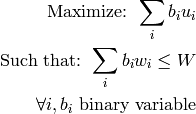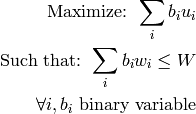This module implements a number of solutions to various knapsack problems, otherwise known as linear integer programming problems. Solutions to the following knapsack problems are implemented:
AUTHORS:
You have already had a knapsack problem, so you should know, but in case you do not, a knapsack problem is what happens when you have hundred of items to put into a bag which is too small for all of them.
When you formally write it, here is your problem:
 .
. you have has a weight
you have has a weight  .
. has a usefulness of
has a usefulness of  .
.You then want to maximize the usefulness of the items you will store into
your bag, while keeping sure the weight of the bag will not go over  .
.
As a linear program, this problem can be represented this way
(if you define  as the binary variable indicating whether
the item
as the binary variable indicating whether
the item  is to be included in your bag):
is to be included in your bag):

(For more information, cf. http://en.wikipedia.org/wiki/Knapsack_problem.)
If your knapsack problem is composed of three items (weight, value) defined by (1,2), (1.5,1), (0.5,3), and a bag of maximum weight 2, you can easily solve it this way:
sage: from sage.numerical.knapsack import knapsack
sage: knapsack( [(1,2), (1.5,1), (0.5,3)], max=2)
[5.0, [(1, 2), (0.500000000000000, 3)]]
We can test for whether or not a sequence is super-increasing:
sage: from sage.numerical.knapsack import Superincreasing
sage: L = [1, 2, 5, 21, 69, 189, 376, 919]
sage: seq = Superincreasing(L)
sage: seq
Super-increasing sequence of length 8
sage: seq.is_superincreasing()
True
sage: Superincreasing().is_superincreasing([1,3,5,7])
False
Solving the subset sum problem for a super-increasing sequence and target sum:
sage: L = [1, 2, 5, 21, 69, 189, 376, 919]
sage: Superincreasing(L).subset_sum(98)
[69, 21, 5, 2, 1]
Bases: sage.structure.sage_object.SageObject
A class for super-increasing sequences.
Let  be a non-empty sequence of
non-negative integers. Then
be a non-empty sequence of
non-negative integers. Then  is said to be super-increasing if
each
is said to be super-increasing if
each  is strictly greater than the sum of all previous values.
That is, for each
is strictly greater than the sum of all previous values.
That is, for each  the sequence
the sequence  must satisfy the property
must satisfy the property

in order to be called a super-increasing sequence, where  .
If
.
If  has only one element, it is also defined to be a
super-increasing sequence.
has only one element, it is also defined to be a
super-increasing sequence.
If seq is None, then construct an empty sequence. By definition, this empty sequence is not super-increasing.
INPUT:
EXAMPLES:
sage: from sage.numerical.knapsack import Superincreasing
sage: L = [1, 2, 5, 21, 69, 189, 376, 919]
sage: Superincreasing(L).is_superincreasing()
True
sage: Superincreasing().is_superincreasing([1,3,5,7])
False
sage: seq = Superincreasing(); seq
An empty sequence.
sage: seq = Superincreasing([1, 3, 6]); seq
Super-increasing sequence of length 3
sage: seq = Superincreasing(list([1, 2, 5, 21, 69, 189, 376, 919])); seq
Super-increasing sequence of length 8
Determine whether or not seq is super-increasing.
If seq=None then determine whether or not self is super-increasing.
Let  be a non-empty sequence of
non-negative integers. Then
be a non-empty sequence of
non-negative integers. Then  is said to be super-increasing if
each
is said to be super-increasing if
each  is strictly greater than the sum of all previous values.
That is, for each
is strictly greater than the sum of all previous values.
That is, for each  the sequence
the sequence  must satisfy the
property
must satisfy the
property

in order to be called a super-increasing sequence, where  .
If
.
If  has exactly one element, then it is also defined to be a
super-increasing sequence.
has exactly one element, then it is also defined to be a
super-increasing sequence.
INPUT:
OUTPUT:
EXAMPLES:
By definition, an empty sequence is not super-increasing:
sage: from sage.numerical.knapsack import Superincreasing
sage: Superincreasing().is_superincreasing([])
False
sage: Superincreasing().is_superincreasing()
False
sage: Superincreasing().is_superincreasing(tuple())
False
sage: Superincreasing().is_superincreasing(())
False
But here is an example of a super-increasing sequence:
sage: L = [1, 2, 5, 21, 69, 189, 376, 919]
sage: Superincreasing(L).is_superincreasing()
True
sage: L = (1, 2, 5, 21, 69, 189, 376, 919)
sage: Superincreasing(L).is_superincreasing()
True
A super-increasing sequence can have zero as one of its elements:
sage: L = [0, 1, 2, 4]
sage: Superincreasing(L).is_superincreasing()
True
A super-increasing sequence can be of length 1:
sage: Superincreasing([randint(0, 100)]).is_superincreasing()
True
TESTS:
The sequence must contain only integers:
sage: from sage.numerical.knapsack import Superincreasing
sage: L = [1.0, 2.1, pi, 21, 69, 189, 376, 919]
sage: Superincreasing(L).is_superincreasing()
...
TypeError: Element e (= 1.00000000000000) of seq must be a non-negative integer.
sage: L = [1, 2.1, pi, 21, 69, 189, 376, 919]
sage: Superincreasing(L).is_superincreasing()
...
TypeError: Element e (= 2.10000000000000) of seq must be a non-negative integer.
Return the largest integer in the sequence self that is less than or equal to N.
This function narrows down the candidate solution using a binary trim, similar to the way binary search halves the sequence at each iteration.
INPUT:
OUTPUT:
The largest integer in self that is less than or equal to N. If no solution exists, then return None.
EXAMPLES:
When a solution is found, return it:
sage: from sage.numerical.knapsack import Superincreasing
sage: L = [2, 3, 7, 25, 67, 179, 356, 819]
sage: Superincreasing(L).largest_less_than(207)
179
sage: L = (2, 3, 7, 25, 67, 179, 356, 819)
sage: Superincreasing(L).largest_less_than(2)
2
But if no solution exists, return None:
sage: L = [2, 3, 7, 25, 67, 179, 356, 819]
sage: Superincreasing(L).largest_less_than(-1) == None
True
TESTS:
The target N must be an integer:
sage: from sage.numerical.knapsack import Superincreasing
sage: L = [2, 3, 7, 25, 67, 179, 356, 819]
sage: Superincreasing(L).largest_less_than(2.30)
...
TypeError: N (= 2.30000000000000) must be an integer.
The sequence that self represents must also be non-empty:
sage: Superincreasing([]).largest_less_than(2)
...
ValueError: seq must be a super-increasing sequence
sage: Superincreasing(list()).largest_less_than(2)
...
ValueError: seq must be a super-increasing sequence
Solving the subset sum problem for a super-increasing sequence.
Let  be a non-empty sequence of
non-negative integers, and let
be a non-empty sequence of
non-negative integers, and let  be non-negative. The
subset sum problem asks for a subset
be non-negative. The
subset sum problem asks for a subset  all of whose
elements sum to
all of whose
elements sum to  . This method specializes the subset sum problem
to the case of super-increasing sequences. If a solution exists, then
it is also a super-increasing sequence.
. This method specializes the subset sum problem
to the case of super-increasing sequences. If a solution exists, then
it is also a super-increasing sequence.
Note
This method only solves the subset sum problem for super-increasing sequences. In general, solving the subset sum problem for an arbitrary sequence is known to be computationally hard.
INPUT:
OUTPUT:
ALGORITHMS:
The algorithm used is adapted from page 355 of [HPS08].
EXAMPLES:
Solving the subset sum problem for a super-increasing sequence and target sum:
sage: from sage.numerical.knapsack import Superincreasing
sage: L = [1, 2, 5, 21, 69, 189, 376, 919]
sage: Superincreasing(L).subset_sum(98)
[69, 21, 5, 2, 1]
TESTS:
The target N must be a non-negative integer:
sage: from sage.numerical.knapsack import Superincreasing
sage: L = [0, 1, 2, 4]
sage: Superincreasing(L).subset_sum(-6)
...
TypeError: N (= -6) must be a non-negative integer.
sage: Superincreasing(L).subset_sum(-6.2)
...
TypeError: N (= -6.20000000000000) must be a non-negative integer.
The sequence that self represents must only contain non-negative integers:
sage: L = [-10, -9, -8, -7, -6, -5, -4, -3, -2, -1, 0, 1]
sage: Superincreasing(L).subset_sum(1)
...
TypeError: Element e (= -10) of seq must be a non-negative integer.
REFERENCES:
| [HPS08] | J. Hoffstein, J. Pipher, and J.H. Silverman. An Introduction to Mathematical Cryptography. Springer, 2008. |
Solves the knapsack problem
Knapsack problems:
You have already had a knapsack problem, so you should know, but in case you do not, a knapsack problem is what happens when you have hundred of items to put into a bag which is too small for all of them.
When you formally write it, here is your problem:
 .
. you have has a weight
you have has a weight  .
. has a usefulness of
has a usefulness of  .
.You then want to maximize the usefulness of the items you
will store into your bag, while keeping sure the weight of
the bag will not go over  .
.
As a linear program, this problem can be represented this way
(if you define  as the binary variable indicating whether
the item
as the binary variable indicating whether
the item  is to be included in your bag):
is to be included in your bag):

(For more information, cf. http://en.wikipedia.org/wiki/Knapsack_problem.)
EXAMPLE:
If your knapsack problem is composed of three items (weight, value) defined by (1,2), (1.5,1), (0.5,3), and a bag of maximum weight 2, you can easily solve it this way:
sage: from sage.numerical.knapsack import knapsack
sage: knapsack( [(1,2), (1.5,1), (0.5,3)], max=2)
[5.0, [(1, 2), (0.500000000000000, 3)]]
sage: knapsack( [(1,2), (1.5,1), (0.5,3)], max=2, value_only=True)
5.0
In the case where all the values (usefulness) of the items
are equal to one, you do not need embarrass yourself with
the second values, and you can just type for items
 the command:
the command:
sage: from sage.numerical.knapsack import knapsack
sage: knapsack([1,1.5,0.5], max=2, value_only=True)
2.0
INPUT:
OUTPUT:
If value_only is set to True, only the maximum useful value is returned. Else (the default), the function returns a pair [value,list], where list can be of two types according to the type of seq:
 for each object
for each object  occurring
in the solution.
occurring
in the solution.